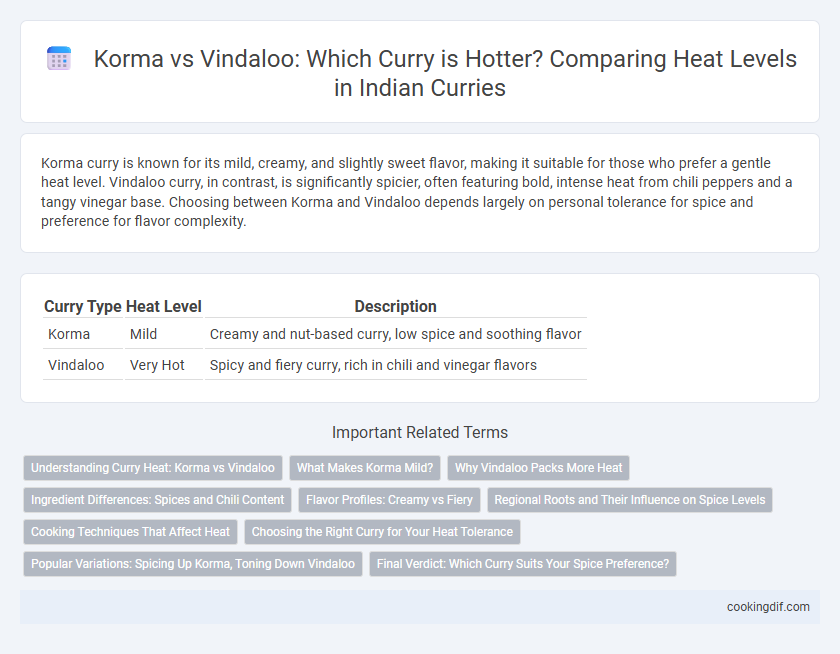Korma curry is known for its mild, creamy, and slightly sweet flavor, making it suitable for those who prefer a gentle heat level. Vindaloo curry, in contrast, is significantly spicier, often featuring bold, intense heat from chili peppers and a tangy vinegar base. Choosing between Korma and Vindaloo depends largely on personal tolerance for spice and preference for flavor complexity.
Table of Comparison
| Curry Type | Heat Level | Description |
|---|---|---|
| Korma | Mild | Creamy and nut-based curry, low spice and soothing flavor |
| Vindaloo | Very Hot | Spicy and fiery curry, rich in chili and vinegar flavors |
Understanding Curry Heat: Korma vs Vindaloo
Korma curry offers a mild heat level, characterized by its creamy, yogurt-based sauce and aromatic spices, making it suitable for those who prefer gentle warmth. Vindaloo curry is significantly spicier, featuring a robust blend of chili peppers, vinegar, and garlic, delivering intense heat that challenges even seasoned spice enthusiasts. Comparing Korma and Vindaloo highlights the spectrum of curry heat, from soothing mildness to fiery intensity.
What Makes Korma Mild?
Korma is mild because it uses yogurt, cream, or coconut milk as a base, which balances the spices and reduces heat. The blend of aromatic spices such as cardamom, cinnamon, and cloves in korma focuses more on fragrance than on chili intensity. Unlike vindaloo, which relies heavily on chili peppers and vinegar for a fiery and tangy flavor, korma offers a creamy and subtly spiced profile, making it ideal for those seeking less heat in their curry.
Why Vindaloo Packs More Heat
Vindaloo curry contains a higher concentration of chili peppers and often incorporates vinegar, which intensifies its heat level and tangy flavor compared to Korma. Korma is typically made with a blend of mild spices, yogurt, and cream that create a richer, milder taste. Vindaloo's fiery spiciness is characteristic of its Goan origins, making it significantly hotter than the smooth, aromatic Korma.
Ingredient Differences: Spices and Chili Content
Korma curry features a mild heat level with a creamy base made from yogurt, cream, and ground nuts, using aromatic spices like cardamom, cinnamon, and cloves to create a rich, subtle flavor. Vindaloo curry is significantly hotter, characterized by a robust blend of dried red chilies, vinegar, mustard seeds, and garlic, delivering an intense, tangy heat. The fundamental difference in chili content and spice combinations results in Korma's gentle warmth compared to Vindaloo's fiery intensity.
Flavor Profiles: Creamy vs Fiery
Korma curry is characterized by its rich, creamy texture derived from yogurt, cream, and ground nuts, offering a mild and subtly spiced flavor profile ideal for those who prefer a gentle warmth. In contrast, Vindaloo is known for its fiery heat level, featuring a bold combination of dried red chilies, vinegar, and robust spices that create an intense, tangy, and spicy experience. The choice between Korma and Vindaloo highlights a spectrum from soothing creaminess to aggressive heat, catering to diverse palates in Indian cuisine.
Regional Roots and Their Influence on Spice Levels
Korma, originating from Mughal cuisine in Northern India, features mild, creamy flavors with yogurt and nut-based sauces, reflecting a preference for subtle heat in that region. Vindaloo, rooted in Goan cuisine influenced by Portuguese colonization, is known for its fiery spice levels, incorporating vinegar and chili peppers to create an intensely hot curry. The regional climate and cultural influences of Northern India and Goa distinctly shape the contrasting spice intensities of Korma and Vindaloo curries.
Cooking Techniques That Affect Heat
Korma and Vindaloo curry heat levels are significantly influenced by their cooking techniques, where Korma involves slow-cooking with yogurt, coconut milk, and nuts to create a creamy, mild flavor that tempers the heat. Vindaloo relies on marinating meat in vinegar and an extensive blend of red chili peppers, combined with frying spices to intensify its spicy heat. The prolonged simmering in Korma reduces capsaicin concentration, while Vindaloo's high-heat frying and acidic marinade amplify its fiery profile.
Choosing the Right Curry for Your Heat Tolerance
Korma curry offers a mild, creamy flavor profile with coconut milk and ground nuts, making it suitable for those with low heat tolerance. Vindaloo ranks among the hotter Indian curries, featuring vinegar, garlic, and a substantial amount of chili peppers to deliver intense spiciness. Selecting between Korma and Vindaloo depends on your personal heat preference, with Korma providing a gentle warmth and Vindaloo catering to enthusiasts who enjoy fiery, bold flavors.
Popular Variations: Spicing Up Korma, Toning Down Vindaloo
Korma typically features a mild heat level with rich, creamy sauces blending yogurt, cream, and ground nuts, making it a popular choice for those seeking subtle flavor. Vindaloo stands out for its intense spiciness, often incorporating vinegar, dried red chilies, and robust spices, appealing to heat enthusiasts. Popular variations of Korma experiment with warming spices like cardamom and cinnamon to gently elevate its profile, while toned-down versions of Vindaloo reduce chili content to balance flavor without overwhelming heat.
Final Verdict: Which Curry Suits Your Spice Preference?
Korma offers a mild, creamy flavor profile with a low heat level, making it ideal for those who prefer gentle, aromatic spices without intense heat. Vindaloo delivers a bold, fiery experience with its high chili content and tangy vinegar base, appealing to spice enthusiasts seeking a significant kick. Selecting between Korma and Vindaloo depends on your heat tolerance: choose Korma for mild warmth and Vindaloo for a robust, spicy challenge.
Korma vs Vindaloo for curry heat level Infographic

 cookingdif.com
cookingdif.com